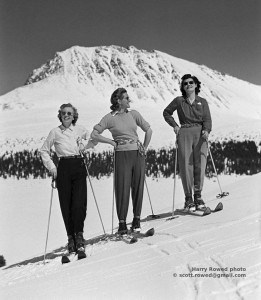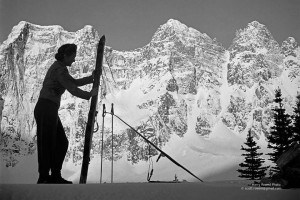When I started researching for old ski stories, I never knew which slope I’d be taken down; there’s so many captivating ski trips from the 1930s, so many soon to be forgotten pockets of slopestyle fun, and so many unique skiing characters to write about.
I had my nose in the Jasper Reflections book, and this next story jumped out like a mogul. I realized that all the stories, old photographs, history and skiing achievements seemed to revolve around men. For example, in the 1930s, Curly Phillips built a cabin and cut some ski runs, Joe Weiss found another ski area, and Frank Burstrom Sr. won yet another cross-country ski race.
I delved deeper, peered into the old grey photos and lo and behold, hiding behind the men were some women as well.
 Part Three:
Part Three:
Hot Women Skiers
What about the women skiers from the 1930s and 1940s?
There had to be some keen, winter shred queens. I dived with female persistence into the books. Soon I saw with blue bird day clarity how incredibly resilient and tough some of these women were.
“Oh boy,” I thought, “This is going to be fun.”
From my initial snooping, it appeared that Doris Kensit and Kay Baxter were the prominent local ski ladies in Jasper National Park. They were the ones frequently mentioned and photographed in most publications of the time, perhaps to the chagrin of the fellas they had out-chicked.
Some other ski devotes were Jean and Phyllis Jeffrey, Dorrie Horsfal and Gen Rowed, along with many more. Limited space in this article prevents me from telling all of their stories. All these women were “a very special generation of Jasperites who pioneered many of the ski trails, peaks and passes.”
I poured through many local books, pestered Karen Byers at the Jasper-Yellowhead Museum and Archives, I chatted with Bob Baxter (who happens to be Kay’s son), I squinted into many black and white photos, scrutinizing and tried to piece together a sketchy and blurred account of where the women skied, what they wore, and most importantly, why they loved to ski.
Doris Kensit was a lucky gal, she was in the right decade at the right time. She twisted luck and braided it in with a free spirit and some ski gumption, and laced up her ski boots with gritty mountain madness.
She started to work for Fred Brewster’s Rocky Mountain Tours in 1929; she ran the office and booked all the trips into the backcountry of JNP. Most women would be content typing all day and filing their nails, but not Doris. She believed that in order to effectively market the trips, she’d have to experience what they were all about. Off she’d go. The Maligne area, Tonquin Valley, and the Skyline Trail became her regular haunts, stomping grounds and playgrounds.
She later reminisced, “I dearly loved the horse trips, but by far the ski trips are my favorite.”
The more I read, the more I started to feel a very strong connection to this ski lady.
Kay Baxter, along with her husband Bob, established the “The Sunset Ice Cream Parlor” and was well known locally for her delicious chocolate cake, but what most didn’t realize was she had skiing prowess, athletic competence and the ability to ski without complaint for many kilometres.
Back in the glory days of backcountry skiing in JNP, there was a booming ski hut business where skiers would book three to four day ski trips into the Watchtower, Maligne and the Tonquin. In those days, Kay would often help Doris with the meals.
 Doris, Kay and Dorrie Horsfal have the distinction of being the first women to ski in the Columbia Icefields area. The ski party would have travelled on the freshly constructed road, and gaped with awe at the Athabasca Glacier, which, at that time, was right next to the road.
Doris, Kay and Dorrie Horsfal have the distinction of being the first women to ski in the Columbia Icefields area. The ski party would have travelled on the freshly constructed road, and gaped with awe at the Athabasca Glacier, which, at that time, was right next to the road.
The ski party slept in shacks, near the soon to be built Columbia Icefields Centre and arose at 2 a.m. to start their ski up the Icefields.
Twelve hours later they gazed out over a mountainous ocean of splendour. The ski back down, according to Doris, was “incredibly fast.”
One has to put in perspective and appreciate the daunting distances that these gals could cover; I reckon they found their own unique female rhythm on their long wooden skis, with bamboo poles beating out the cadence. The creases on their ski pants, blouses and the curls in their hair would have wrinkled, and flattened, as sweat and effort replaced the “put together outfit” of the day. They would have arrived at the cabin with as much perspiration as the men, a buzzed look of exertion in their eyes and then promptly rolled up their sleeves to take care of the cabin chores.
There is still the question of why the ladies of that era loved to ski. What was it?
Was it the marvellous feeling of gliding along on a simple, but complex winter canvas, where you can express yourself in various styles, swings and swooshes, leaving in your wake a temporary parallel ribbon of bliss?
This feeling feels no age and is the most innocent and exhilarating emotion to possess. It brings to mind Frank Darlow’s poem, Skis:
“They’re never too crippled and never too old,
They love the deep snow, and they don’t mind the cold,
Don’t mind if they starve, and don’t care if they freeze,
As long as they’re out on those wonderful skis.”
I feel that Doris has passed her skiing baton to me. “She loved to sit out on the balcony amidst her blossoming fuchsias and geraniums. While the hummingbirds darted in for nectar, she would smile and savour the mountain vistas around her; Cavell, the Whistlers, Tekarra and the ridges of the Skyline Trail.”
This paragraph twanged a sentimental chord for me. It pretty much sums it all up.
Loni Klettl
Special to the Fitzhugh
Jasper Ski History is a four-part series written by Jasper trail guru Loni Klettl. The first installation in the series titled “Trapper Creek, The Rescue” appeared on Feb. 4 and the second “Parking Lot Promise” appeared on Feb. 18. Find them both at www.fitzhugh.ca
